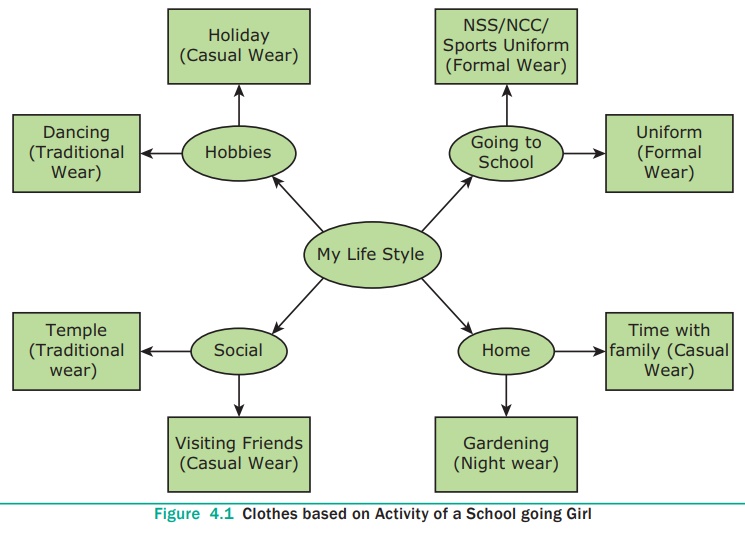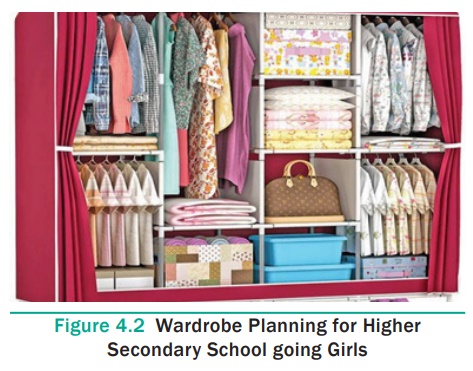Textiles and Dress Designing - Wardrobe Planning | 12th Textiles and Dress Designing : Chapter 4 : Family Clothing Budget and Wardrobe Planning
Chapter: 12th Textiles and Dress Designing : Chapter 4 : Family Clothing Budget and Wardrobe Planning
Wardrobe Planning
WARDROBE PLANNING
Definition
The wardrobe planning is to select clothes that are so basic in
style and good in design that they are appropriate for the present set up as
well as suitable for a few years to come. To device maximum satisfaction one
must develop good clothing practices. Good clothing practice includes the
knowledge of wise selection of clothing, possession of an adequate wardrobe
suited to various occasions which in turn helps in proper dressing habit.
·
Wardrobe planning is influenced by many factors. The most common
are Aesthetic, psychological, sociological and economic factors.
·
Individual taste, social surroundings and family income.
·
Age, sex, occupation of the family members.
·
Durability, quality of clothing items, price, appearance and ease
of care.
·
The climate conditions, activities of a person, state of health.
·
Fashion and lifestyle.
1. Steps in Wardrobe Planning
·
Sort and Purge
Remove items from your closet and drawers. As you remove items,
sort them into one of four items:
·
“Store” (for seasonal items)
·
“Repair/Clean” (items which need hemming, buttons, cleaning)
·
“Donate” (Useable items with no repairs or cleaning needed)
·
“Toss” (items that are too worn or cannot be repaired)
If we haven’t worn something for a year, definitely it should be
donated or toss it. Once the items are removed, bag them up to send to their
respective places. Items to be stored in vacuum -storage bags and put under the
bed or in your storage locker; anything to be repaired or cleaned needs to be
taken immediately to the drycleaner can be obviously tossed.
·
Shop in Your Own Closet
Once you have finished sorting and purging, make a note of the
items that are left in your closet and drawers. Group

them according to type; formal wear, casual wear, fancy wear,
accessories, mix and match items to create new outfits.
·
Make a List
In order to follow mixing and matching, make a list of the items
you need to purchase to complement your existing one. Make a note of new
clothed to be purchased. This list is the basis of your wardrobe plan.
·
Set Your Budget
Estimate the cost of the garments need to purchase.
·
Determine Time and Place
Decide what time of year each piece needs to be purchased and what
to purchase these items. For example, a great time to purchase a winter coat
for cost savings is actually at the end of winter. The choice of store is
determined by your budget and location. Allocate time and funds from your
budget for shopping. Once per season is the recommended. A minimum of two hours
should be allocated to each shopping.
·
Finalizing the Wardrobe
After following the basic steps to create a plan for your
wardrobe, shopping is much easier and far more cost effective. Organize your
wardrobe to get the maximum efficiency and minimize the stress associated with
getting dressed in the morning.
2. Wardrobe Planning for a Higher Secondary School Going Girls
Clothing is of greater importance during teenage than during any
other period. It is a fascinating period of transition brought about by the
onset of puberty. Profound physical changes, new found cognitive ability,
increased social pressure and
a new educational environment exerts a strong influence on the developing
individual. It is a time of insecurity and a period of heightened interest in
clothing. It is a period in which clothes have a greater effect upon the individual.
During this stage they realize that clothing can do much to improve appearance
and camouflage an unattractive appearance.
The higher secondary school going girls has a wide range of choice
for clothes open to her ranging from the traditional to the most modern. In
fact, most girls today wear a mixed array of clothes like – jeans, T-shirt,
skirt and blouse, churidar-kurta, lehenga choli, half sari.
Some girls feel that they could dress well if only they had a lot
of money to spend on clothes. Of course, money do help. But it is possible for
a girl from an average income family to appear better dressed than a girl whose
family is in the upper income group. It isn’t the money spend on a wardrobe but
the thought that is put into selecting it that really counts. Various dresses
may be selected according to the role an individual has to play. Hence for
travelling, working, playing and sleeping purposes different outfits are used.

3. Wardrobe Planning for Higher Secondary School Going Boys
Today teenage boys are becoming more and more fashion conscious,
more sophisticated and more selective. They are exposed to and have access to
information about everything like never before. The higher secondary school
going boys have many things in common. They have to select clothes suitable for
different occasions – school, formal, informal, parties, sports and traditional
wear. Their wardrobe is mainly made up of basics like undergarments, jeans and
T Shirts. For casual wear they prefer short, Bermudas, track pants and T
Shirts. The teenagers like to try new fashions and update their wardrobe. The
biggest expenses in the


The clothes worn by teenage boys must
be suited to the wearer, the seasons of the year, the time of the day, the
occasion to which they are to be worn and accepted style of the day. The boys
are more conscious about their personal appearance and peer group acceptance,
try to change their clothing behaviour and always attempt to be on par with
current fashion.

Division of Budget
A budget should eventually be planned to cover expenditures and
savings for a year. To get started you can plan month by month.

Related Topics